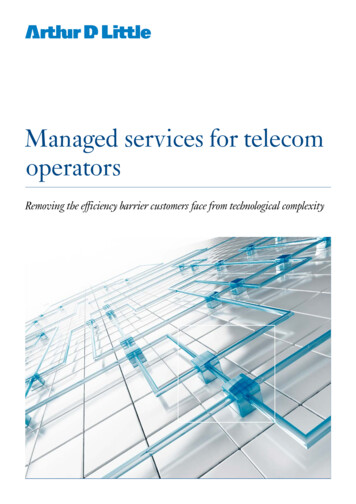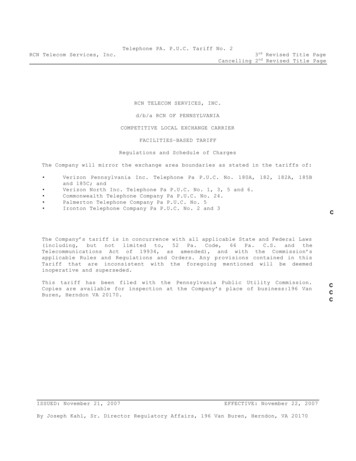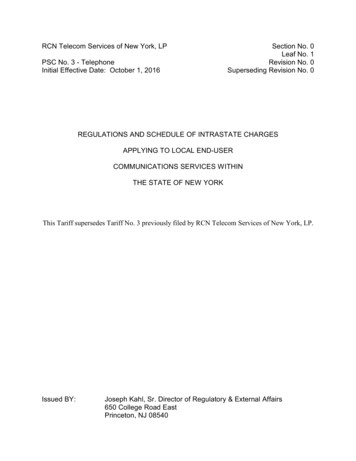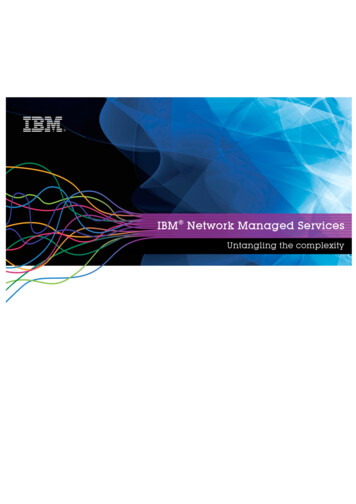
Transcription
Managed services for telecomoperatorsRemoving the efficiency barrier customers face from technological complexity
ContentExecutive summary31. Managed services take complexity off customers’ shoulders while guaranteeing “that it simply works”52. Managed services represent an attractive growth opportunity for telecom operators73. Telecom operators have all the assets to capture value from the managed services opportunity84. To succeed, operators need to articulate the ambition level and playing field105. The managed services transformation lays the basis for competing in the cloud & ICT space11Authors:Karim TagaBela ViragGlobal Practice LeaderTIME Austriataga.karim@adlittle.comAssociate DirectorTIME Austriavirag.bela@adlittle.comAndrea FaggianoRussel PellAssociate DirectorTIME Italyfaggiano.andrea@adlittle.comPartnerOperations Management UKpell.russell@adlittle.com
Executive summaryManaged services are becoming increasingly popular with businesses around the world. The globalmarket for managed services is expected to grow from USD 160 billion in 2014 to USD 286 billionin 2019, at an estimated CAGR of 12% over the next few years.In our last publication on managed services, we have focused on the opportunity. This paper willshed more light on the delivery complexities. Global customers demand service that is uniformworldwide, with all the operational complexities this entails. At the same time, national mid-sizedand even small enterprises require factory-like delivery of managed services.Customers buy managed services to increase staff productivity beyond the complexity barrier.Examples include integrating a unified communication system with a Microsoft Exchange solution,establishing a single-sign-on federation mechanism and the like. However, for operators this meansthat successfully delivering managed services requires them to be more efficient in managing theclient’s technical complexity than the clients themselves are. And this is precisely where theproblem rests.Benchmarks indicate that managed servicescustomers are willing to pay up to five timesmore for managed services than theirunmanaged counterparts. By contrast,worldwide prices for unmanaged or best-effortconnectivity are likely to remain under pricepressure, as competition between telecomoperators remains undifferentiated.The new norm entails a number of shifts:1. from price- and feature-based selling tosolution based selling,2. from a product delivery setup to a setup thatallows for delivering client-specified services,3. from best effort to SLA oriented operations.As a result telecom operators must open their internal, silo-based operating models up and starttaking customer problems seriously. 3
Managed services for telecom operators1. Managed services take complexity off customers’shoulders while guaranteeing “that it simply works”Adding a management layer to basic services helps grow beyond best-effort, unmanagedservices and enables tapping into servicing business-critical applications“Managed services” refers to managing customers’ technologyenvironments on an ongoing basis through standardizedofferings designed to deliver on standard or agreed-upontarget SLAs. Managed services are typically offered to coverbusiness-critical services – functions that are at the heart ofa business. Examples of those critical services range froma key-card computer at a hotel that hands out room keys forguests arriving on weekends (exactly when traditional callcenters cannot deliver expert support), to SAP modules thatcontrol the supply chain of just-in-time manufacturing facilities,all the way to managing the data center of the stock exchangeor flight-control systems. Although the latter have no option tofail, even the smaller or seemingly insignificant services mustnot be interrupted when considered from the viewpoint of therespective businesses.Current telecom offerings for managed services can be brokeninto six main product groups, as illustrated in Figure 1.Managed services also entail the ability to manage thecustomer solution “end to end” by offering active-monitoringfeatures to the provided solution and proactively reporting faultsand incidents, while ensuring that restoration happens withinthe committed SLAs.The challenge of maintaining “end-to-end” SLAs that are relevantand beneficial from a client point of view grows exponentiallyas the complexity of the solution increases. An example: it isvery different to promise your customer that its employees willbe able to send and receive emails on their mobile phones fromselling a phone, a SIM and an Office 365 license.Figure 1: Example of a managed services portfolioVoice & DataManagedVoice & Data Managed fixed andmobile voice &Broadband Managed VoIP ManagedAudio/Videoconferencing UnifiedCommunication Mobile engagementManaged VoiceSystems andCall Center Managed PBX Managed CallCenters Call recording PBX/ call centersconsulting, design &integration4Enterprise NetworksSecurityEquipmentManaged LAN/WANManaged SecurityManaged Mobility WAN/LANconsulting, design &integration Managed LAN Managed WAN Managed WAN(Layer 2-3) FMI Data ManagedInternationalNetworks Managed enterpriserouters & switches Applicationacceleration Firewalls & IPconcept Managed VPN Securitymaintenance Security consulting Security policydevelopment Virus- and Spamprotection Risk & complianceassessment Enterprise MobilityManagement Device Management(Handsets, Tablets,Field Force Devices.)Managing disasterrecoveryManaged Office /IT Equipment Backup & disasterrecovery systems Business continuityservices Managed desktop Managedprint services Printing & scanningmanagementsoftware Printer & scannerdevice management ResellingData Center & CloudManaged Housing /Co-location Managed housing Managed co-locationManaged Hosting / IaaS Servers hosting Managed servers Managed storage Web Hosting Server virtualization Desktop virtualizationPaaSApplicationsManaged Software Applicationsmanagement andtroubleshooting SAP, CRM, BI andERP consulting,design & integrationM2M Deployment Fleet & freightenvironmentmanagement Runtime environment Industrial solutionsSaaS Application hosting (software,appstore, webshop) Deployment environment Workflow management
Managed services for telecom operatorsHowever, from many interviews and case work, we havelearned that indeed many operators, actually shy away fromthe related technical complexity. Asked, if they would feelcomfortable securing their national stock exchange or air-trafficcontrol, the most common answer was that they would feelcomfortable “delivering the circuits”. That is exactly why manyoperators are prone to become bit-pipes. The complexity ofspecification and design rests in the customers’ hands, andoperators are on the receiving end of an order. So why do operators not take technological complexity off theircustomers’ shoulders? Or, asked differently: why are operatorsnot shying away from sell payment systems to supermarkets (ifthey succeed) while they are shying away from securing moreobviously vital applications? In either case, there is nothing togain from providing unfit services to customers. It is dangerousfor the customer - and customers know it.5
Managed services for telecom operators2. Managed services represent an attractive growthopportunity for telecom operatorsOperators, in emerging and mature markets alike, will continueto face challenging times, as unmanaged connectivity priceshave been declining and can be expected to further erode in thefuture, driven by a range of dynamics.1. Capacity is still abundant, and continues to grow faster thandemand.2. Incremental cost for the utilization of that bandwidth isminimal compared to incremental revenue, and incrementaloperating costs are often negligible.3. Technological advances reduce the cost of upgradingcapacity on existing assets for all network asset classes:copper, HFC, fiber and over-the-air technologiesThe transformation of once-praised connectivity services intoundifferentiated commodities makes the case for managedservices all the more compelling for telecom operators.Businesses increasingly depend on constant uptime of servicessuch as connectivity (voice and data), security, managedequipment, cloud and software applications, as all are majorlifelines. This is the core reason that, if sold properly, businessesare willing to pay substantial premiums for services that comewith performance guarantees. Our benchmark of leadingtelecom operators indicates premiums for managed servicesFigure 2: Pricing of managed services versus unmanaged services1.5x – 5x1.2x – 2x1.5x – 4xConnectivityComputingApplicationsSource: Interviews, Arthur D. Little analysis6ranging from 20% to 400%, depending on the nature ofservices (Figure 2).Although readiness to pay may be there, we have seen manyoperators lack sales abilities (as well as delivery abilities, whichwe explore in the next section) when attempting to embark onthe journey into selling managed services. This is mostly due tothree deficiencies:1. A lack of product availability to the sales teams of trulymanaged services (e.g. an empty toolbox)2. A lack of process maturity during the sales phase to properlydetect and describe a client problem in which technicalcomplexity is of significant concern, with monetary impacton the client.3. A lack of structured pre-sales engineering and support,coupled with a one-man-show understanding of accountmanagers.It seems that although demand is growing and customers arewilling to pay premium prices, operators are still set up to sellcommodity connectivity and leave managing complexity to theircustomers – or chance.
Managed services for telecom operators3. Telecom operators have all the assets to capturevalue from the managed services opportunityNot withstanding all the issues raised above, Arthur D. Littlegenerally believes that telecom operators can and should selland deliver managed services. Telecom operators have all theassets they need to offer and operate managed services: ahighly available and secure network and IT, a 24/7 operationscenter, device and application monitoring tools and capabilitiesrelated to planning, building and running a network.However, we see many operators struggle with thetransformation required to utilize these assets and capabilitiesfor managed services: to take them from a network-widelevel to a customer-individual level. It requires giving up certainparadigms:1. Usually, the infrastructure used for client services is keptdeliberately separate from the infrastructure used forthe supplier’s own services. Cloud services are a goodexample, as well as also UC, IP-Centrix, or hosting services.Surprisingly, against common sense, customers’ cloudservices are run in separate environments from the carrier’sown virtualized machines.2. Operating teams for customer services are also distinctivelyseparate from those teams operating own core platforms.Although there are teams looking after the operator’sown services 24/7, individual client services are often notsupported to the same extent.3. Lack of proper documentation of their network assets. Thisis a big issue, in both corporate valuation and deliveringquality services. Without physical and logical configurationsreadily available to operating teams, any incidentmanagement crumbles and turns into detective work.Numerous audits in Europe and MENA have revealed thatoperators do not always properly manage their inventoryor configurations. They pay for long-decommissionedcircuits, cause outages due to faulty configuration andassume redundancy on non-disjoint or congested links.For these reasons, it is not surprising that network faultsdue to construction make up only 10–15% of all faults, theremainder being self-inflicted.Figure 3: Telecom operators typical capabilities across the Managed Services cycleUnmanaged servicesPlan &buildActivateBillChannel mgt.N/A.Sales mgt.N/A.Pre sales /project mgt.MarketingN/A.N/A.Managed servicesStrategy &planning & set upAcquisition& buildLifecycle mgt.N/A.N/A.CustomerServiceOperationsEstablished activity Areas where known issues existExisting methods typically do not suffice7
Managed services for telecom operators4. Incident management is often inaccessible. Only fewoperators offer accessibility to the client and expose theirtechnical administrators to direct communication channelswith the client’s relevant service.After assessing numerous operators’ capabilities during the last24 months using a standardized capability assessment matrix,we can only confirm our prior findings that most operators areless equipped to deliver managed services than unmanagedservices. (See Figure 3 overleaf)Consequently, if operators embark on leveraging the managedservices opportunity, they will need to enhance their assetmanagement and configuration management tools, as well astheir incident management and release management processes.Transforming current approaches into a fully transparent,clientaccessible entity that manages assets, configurations andincidents well is comparable to turning an industrial kitchen intoan open-view kitchen. It first requires some clean-up.Once the basics have been fixed, a customer-centric operatingmodel needs to be established, integrating four key domains:platform build out, service creation, sales and operations(Figure 4). An operational set-up dictates dedicated supportfunctions centered along providing, ensuring and maintainingstrict SLAs and constant quality support.Figure 4: Operating model principles along simplified value chainPlatformbuild-outDeliveryelements How are platformcreation decisions taken? How are productdevelopment decisionstaken (roadmap &content)? Who has CAPEX / howassigned?8Service creationPropositionsSalesSolutions Is there a coordinatedeffort in scouting focusand result sharing? How are client specificsolutions being calculated& budgeted? Who manages partnerrelations? What is
Managed services are becoming increasingly popular with businesses around the world. The global market for managed services is expected to grow from USD 160 billion in 2014 to USD 286 billion in 2019, at an estimated CAGR of 12% over the next few years. In our last publication on managed services, we have focused on the opportunity. This paper will











